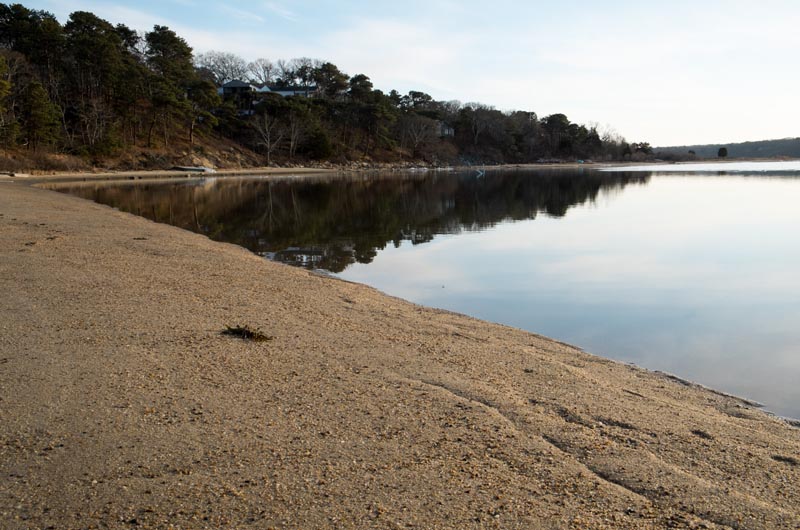A proposed watershed planning district in Oak Bluffs and Tisbury would lay the groundwork for added wastewater regulations around the Lagoon Pond, and for greater public participation as the two towns work to restore the estuary.
An article on annual town meeting warrants in both towns this month will ask voters whether to approve the Island’s first nitrogen management district as part of a longer-term management plan for the watershed.
The Lagoon Pond watershed spans more than 4,000 acres, in Oak Bluffs, Tisbury, West Tisbury and Edgartown. But most of the watershed, including the pond itself, lies in Oak Bluffs and Tisbury. The watershed planning district idea comes in response to the Massachusetts Estuaries Project, which reported in 2011 that the Lagoon’s habitat ranges from moderately impaired to severely degraded.
Town leaders in Oak Bluffs and Tisbury hope to develop a targeted wastewater management plan, which requires officially identifying the watershed area. The new district would share the boundaries of the Lagoon Pond watershed, as previously determined by the Martha’s Vineyard Commission, but only within the two towns.
As with many coastal ponds on the Vineyard, an excess of nitrogen, mostly from outdated septic systems, has greatly altered the Lagoon’s natural habitat. Too much nitrogen fuels the growth of algae, which deprives eelgrass and other pond organisms of light and oxygen. The Lagoon eelgrass population has been declining at least since the 1990s.
The MEP has completed reports for about half of the estuaries on the Vineyard, providing nitrogen threshold concentrations for each of those ponds. Towns are not bound by the MEP reports, although town officials have warned that the state Department of Environmental Protection, which oversees the MEP, will likely end up mandating the thresholds.
Last year, Oak Bluffs and Tisbury formed a joint watershed planning committee — also the first of its kind on the Island — to explore shared solutions for the Lagoon. Committee member Gail Barmakian, who is also an Oak Bluffs selectman and wastewater commissioner, said the new district would serve mostly as a planning tool, with specific regulations to come later. “It’s really just to identify where the watershed is, and having the town accept that,” she said.
She added that the district would alert people living within the watershed as to how they may be contributing to the problem. She was careful to avoid the term overlay district, which she said would connote zoning changes, which are not part of the proposal.
The management district is unlike a district of critical planning concern (DCPC), since it does not come with a set of regulations. And some parts of the district could end up being managed differently than others. The Martha’s Vineyard Commission established a DCPC around the Lagoon in 1988, but it extends only 1,500 feet from the shore.
Tisbury selectman and wastewater commissioner Melinda Loberg, who also serves on the joint committee, said the management district would send a clear message that the towns were approaching the problem from a watershed, rather than a town-by-town perspective. “This is a shift in everybody’s thinking and their automatic responses,” Mrs. Loberg said last week at a meeting of the Martha’s Vineyard Water Alliance, an Islandwide advocacy group.
“Now we are being really specific: Here is the border,” she said. “You’re in it or you’re out of it. And there will be some things happening if you’re in it. We don’t know what they are yet, and we are not going to implement everything all at once. It’s going to be a targeted, step-by-step process.”
The water alliance has also discussed the possibility of installing educational materials in Island libraries and Steamship Authority terminals, and re-publicizing watershed-related videos on MVTV. Alliance president Megan Ottens-Sargent said she believes Island groups should focus more on educating town officials, especially in regard to the implications of the MEP. “I am under the impression that they aren’t up to speed on the fact that there will be a mandate,” she said.
While the proposed district is only in Oak Bluffs and Tisbury, Mrs. Loberg said she hopes West Tisbury will eventually get involved as well. West Tisbury accounts for a small portion of the Lagoon watershed, but a much larger portion of the watershed for Lake Tashmoo, which also extends into Oak Bluffs. Most of the Tashmoo watershed is in Vineyard Haven.
Edgartown likely has the smallest impact on the Lagoon, since that portion of the watershed covers only a small area in the state forest.
Mrs. Loberg said she believes Tisbury voters were generally aware of watershed issues, since town officials have been discussing them for years. But she didn’t know how the articles would be received at the town meetings.
Ms. Barmakian called wastewater a “top-five” priority in Oak Bluffs and anticipated support for the article. “I haven’t heard anything negative,” she said.






Comments
Comment policy »